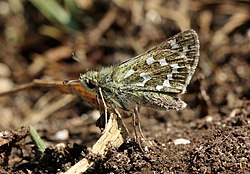This article includes a list of general references, but it lacks sufficient corresponding inline citations .(July 2025) |
| Silver-spotted skipper | |
|---|---|
 | |
| Female | |
 | |
| Female underside, Aston Rowant, Oxfordshire | |
| Scientific classification | |
| Kingdom: | Animalia |
| Phylum: | Arthropoda |
| Class: | Insecta |
| Order: | Lepidoptera |
| Family: | Hesperiidae |
| Genus: | Hesperia |
| Species: | H. comma |
| Binomial name | |
| Hesperia comma | |
| Subspecies | |
See text | |
| Synonyms | |
| |
Hesperia comma, the silver-spotted skipper or common branded skipper, is a butterfly of the family Hesperiidae. It is known as silver-spotted skipper in Europe and common branded skipper in North America where the butterfly Epargyreus clarus , a spread-winged skipper, also has the common name of "silver-spotted skipper".



